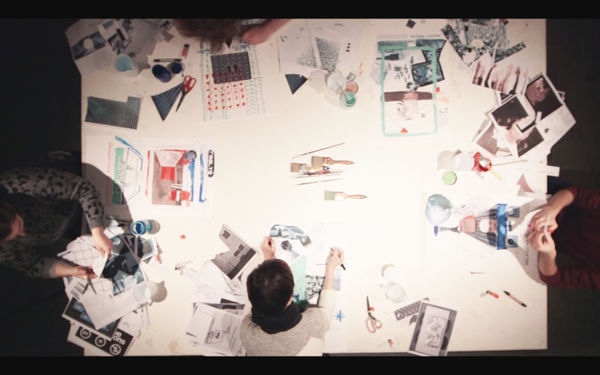Synopsis text
[please try it without headings:]
For my graduation project I made an experimental publication entitled "From the action-image to the interaction-image. Interaction as a cognitive model".
The project is divided in 3 parts: the theoretical research of my thesis, the collaborative graphic design of the publication and the installation showcase of the project. With this work I'm exploring how our interaction technologies influences the parameters of the designers and the users, and which are the design models created by them.
The publication comes as a result of a game / performance where some people produced together a series posters, basis of its corporate identity.
The images of the publication were partially generated during a performance. Five people were asked to represent within five empty posters the key words of the five chapters of my thesis.The materials that they were willing to use were a series of printed pictures, five different markers and paint, brushes, glue and scissors. The pictures were selected by choosing a few key words of the thesis, searching those words on Google images and printing the first three raws. Every five minutes an alarm was announcing to give the poster to another person. The result is a drawing chain, a tangible example and parody of an interactive process of design. I used these posters to divide all the chapters of the thesis, and the images that the participants of the performance used to design the posters as illustrations of the contents of the text.
In choosing a collaborative method to design my thesis I emphasize the relationship between media technologies and humans. The people were working as a machine, with sources, tools and a limit of actions. In spite of the apparent limited setting, the results were unexpected and rich of useful inputs for the fulfillment of the whole project. In leaving the control to a collectivity I decide to work as an "organic software". In letting people feeding this work with their actions and interpretations I practice what is for me an example of a conscious and sustainable method of communication. I believe that only experiencing an information we are able to understand and grasp its meaning. In providing directions and making tools accessible, the public is free to shape their own critical and conscious methods of design.
[first version>]
What?
For my graduation project I made an experimental publication entitled "From the action-image to the interaction-image. Interaction as a cognitive model". The project is divided in 3 parts: the theoretical research of my thesis, the collaborative graphic design of the publication and the installation showcase of the project. With this work I'm exploring how our interaction technologies influences the parameters of the designers and the users, and which are the design models created by them. The publication comes as a result of a game / performance where some people produced together a series posters, basis of its corporate identity.
How?
The images of the publication were partially generated during a performance. Five people were asked to represent within five empty posters the key words of the five chapters of my thesis.The materials that they were willing to use were a series of printed pictures, five different markers and paint, brushes, glue and scissors. The pictures were selected by choosing a few key words of the thesis, searching those words on Google images and printing the first three raws. Every five minutes an alarm was announcing to give the poster to another person. The result is a drawing chain, a tangible example and parody of an interactive process of design. I used these posters to divide all the chapters of the thesis, and the images that the participants of the performance used to design the posters as illustrations of the contents of the text.
Why?
In choosing a collaborative method to design my thesis I emphasize the relationship between media technologies and humans. The people were working as a machine, with sources, tools and a limit of actions. In spite of the apparent limited setting, the results were unexpected and rich of useful inputs for the fulfillment of the whole project. In leaving the control to a collectivity I decide to work as an "organic software". In letting people feeding this work with their actions and interpretations I practice what is for me an example of a conscious and sustainable method of communication. I believe that only experiencing an information we are able to understand and grasp its meaning. In providing directions and making tools accessible, the public is free to shape their own critical and conscious methods of design.

